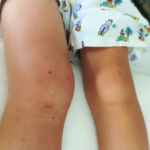She was diagnosed with rheumatoid factor-positive, polyarticular JIA.
“These [JIA] patients can be rheumatoid factor positive or negative—although it’s rare to see a positive rheumatoid factor in JIA,” Ms. Kremer said. “It accounts for less than 5% of patients. When positive, it’s considered the equivalent to the adult form of rheumatoid arthritis.”
In this form of JIA, joints are often involved symmetrically, with both large and small joints affected. Fewer than 50% of these patients go into remission without medications.
Along with the medications considered for the previous case, biologics are an option. If a patient doesn’t respond to one anti-tumor necrosis factor (TNF) drug, such as adalimumab, etanercept or infliximab, they may respond to another anti-TNF, she said.
Other treatment options include the CTLA-4 inhibitor, abatacept, and the IL-6-inhibitor, tocilizumab. All of these treatments require monitoring with complete blood count (CBC) and liver function tests. With tocilizumab, periodic lipid panels are also needed, Dr. Lynton noted.
Clinicians treated the patient in the second case with 0.5 mg/kg subcutaneous methotrexate weekly, as well as oral folic acid daily and 8 mg of ondansetron every eight hours for nausea, or as needed. At the same time, 0.8 mg/kg etanercept was given every week. The patient was on a nonsteroidal anti-inflammatory drug (NSAID), with the plan of stopping it upon remission. Baseline testing and subsequent monitoring were needed for tuberculosis, hepatitis B, hepatitis C, serum creatinine and CBC with differential and liver function tests.
Biologics
Despite the increased care necessary to monitor such patients, the use of biologics has been a huge step forward in the field. Dr. Lynton showed a picture of a mother who didn’t have access to biologics at the start of her disease and had hands with permanent, disfiguring damage. She was seated next to her son with JIA, who had been treated early with biologics and had hands that appeared normal.
“Biologics have revolutionized the outcomes in polyarticular JIA,” said Dr. Lynton.
Thomas R. Collins is a freelance writer living in South Florida.

